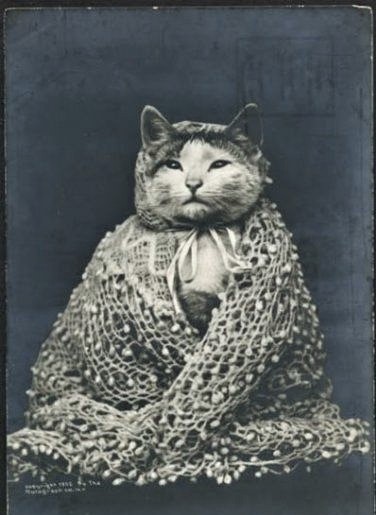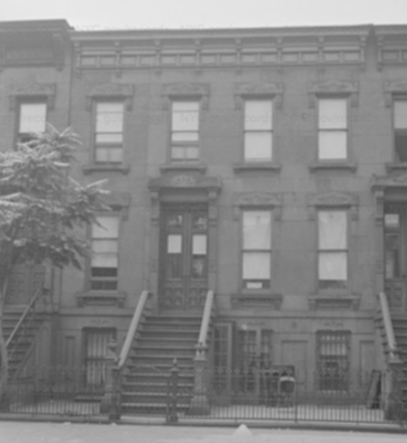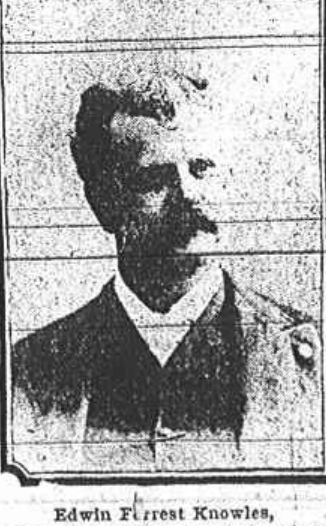
“It is a wise cat that knows its own birthday, and Mrs. Edwin Knowles’ feline is wise, indeed.”–New York Dramatic Mirror, July 15, 1899
On July 5, 1899, Ko-Ko celebrated the thirteenth anniversary of his appearance on earth. The New York Dramatic Mirror noted, “Superstition has no place in the philosophy of Ko-Ko, so he didn’t mind coming right out and admitting the thirteen, though he doesn’t look a day over seven.”
To celebrate her beloved cat’s birthday, Mrs. Edwin Knowles (nee Sarah Goodrich) had a fancy breakfast in her home at 868 Lafayette Avenue in Brooklyn.
The guests included those high-society women who supported her in the recent elections of the Professional Women’s League. (Mrs. Knowles had run for president, but she was defeated by Mrs. A.M. Palmer). Many of the young ladies in attendance wore white and had flowers woven into their hair.

Ko-Ko, described as “perfectly formed, with beautiful tiger stripes and pale green phosphorescent eyes,” received with his mistress in the drawing room, barely taking notice of the numerous neck beads, framed engravings, and other gifts that were presented to him. One newspaper observed, “the birthday festival (was) similar to the memorable one that the Empress Eugenie gave to Napoleon III.”
During the breakfast, Ko-Ko dined on milk, crackers, rice pudding, and almonds. The New York Times pointed out that Ko-Ko was a temperance cat, and therefore did not join the ladies in drinking to his health with wine.
The feline guest of honor wore a collar of pearls of Egypt, described as “purple and brilliant.” He sat on a green silk cushion embroidered with leaves of the Lotus Alba. In addition to the gifts, the guests presented him with ribbons and flowers.

Following the meal, the women danced a quadrille for Ko-Ko and read poetry while the cat “assumed the hieratic attitude of the goddess Pacht that the Pharaohs revived, and impressively he seemed to be her rightful heir in this lackadaisical age, that does not idolize cats.”
Many newspapers reported on the story and described Ko-Ko in detail. One newspaper said: “He is faithful to his home, he is affectionate without servility, he is charmingly decorative.”
Replying to a compliment about her cat, Mrs. Edwin Knowles said, “I am not worthy of lending any celebrity to Ko-Ko. He, rather, may make me famous.”
Sarah and Edwin Knowles
Sarah Goodrich Knowles was a Broadway actress when she met her theatrical husband, Edwin Forrest Knowles, in the 1870s. Knowles was also an actor at this time, but he would go on to manage numerous theaters, including the Grand Opera House in Brooklyn and the Fifth Avenue Theatre in Manhattan.
Born in Rhode Island in June 1846, Edwin Knowles began his theatrical career as an actor and chorus member with the Worrell Sisters at the old New York Theatre on Broadway. He married Sarah Goodrich in 1876, and six years later partnered with Colonel Theodore Morris as co-manager of Hyde and Behman’s Grand Opera House at 18 Elm Place in Brooklyn (now the site of a large parking garage).

The Wolf of the Amphion Theatre

In 1888, Edwin Knowles opened the Amphion Theatre on Bedford Avenue in the Eastern District (Williamsburg). The four-story theater could reportedly seat 1,700 patrons and initially featured operas and dramas.
The Amphion Theater made the headlines in December 1910 when a wolf broke loose from its cage on the stage and bit eight people in the audience. According to the New York Times, the breakout occurred during the third act of “The Queen of the Highway.”
As the wolf made its way up the aisle, terrified men and women struggled with each other to run to the rear of the auditorium and out the doors. Policeman John J. Cosgrove of the Clymer Street Station tried to stop the wolf as the enraged animal tore away at his trousers.

Several stage hands tackled the wolf and threw a bag over its head. Dr. Dagler, who was in the audience, attended to the inured women, many of whom had fainted. When all was back in order, the stage hands raised the curtain and the last act was completed as if nothing had happened. Typical Old New York.
The theater eventfully became a cinema in the silent era. It was sold at auction in 1922 and continued to operate as a cinema until the 1930s.
The Amphion Theatre was demolished in 1940 as part of a slum clearing project. Today the land is occupied by the Bedford Playground.
By the time the wolf had made its escape, Edwin Knowles had been dead for eight years. He died in his home in April 1902 following an almost yearlong bout with severe paralysis. His cremated remains were placed in the family vault in Rhode Island.
Sarah Knowles continued to do charity work in Brooklyn until her death in March 1924 at the age of 75. The couple never had children; Ko-Ko, of course, would have been long gone, but there was no mention of any feline survivors in Mrs. Knowles’ obituary.



